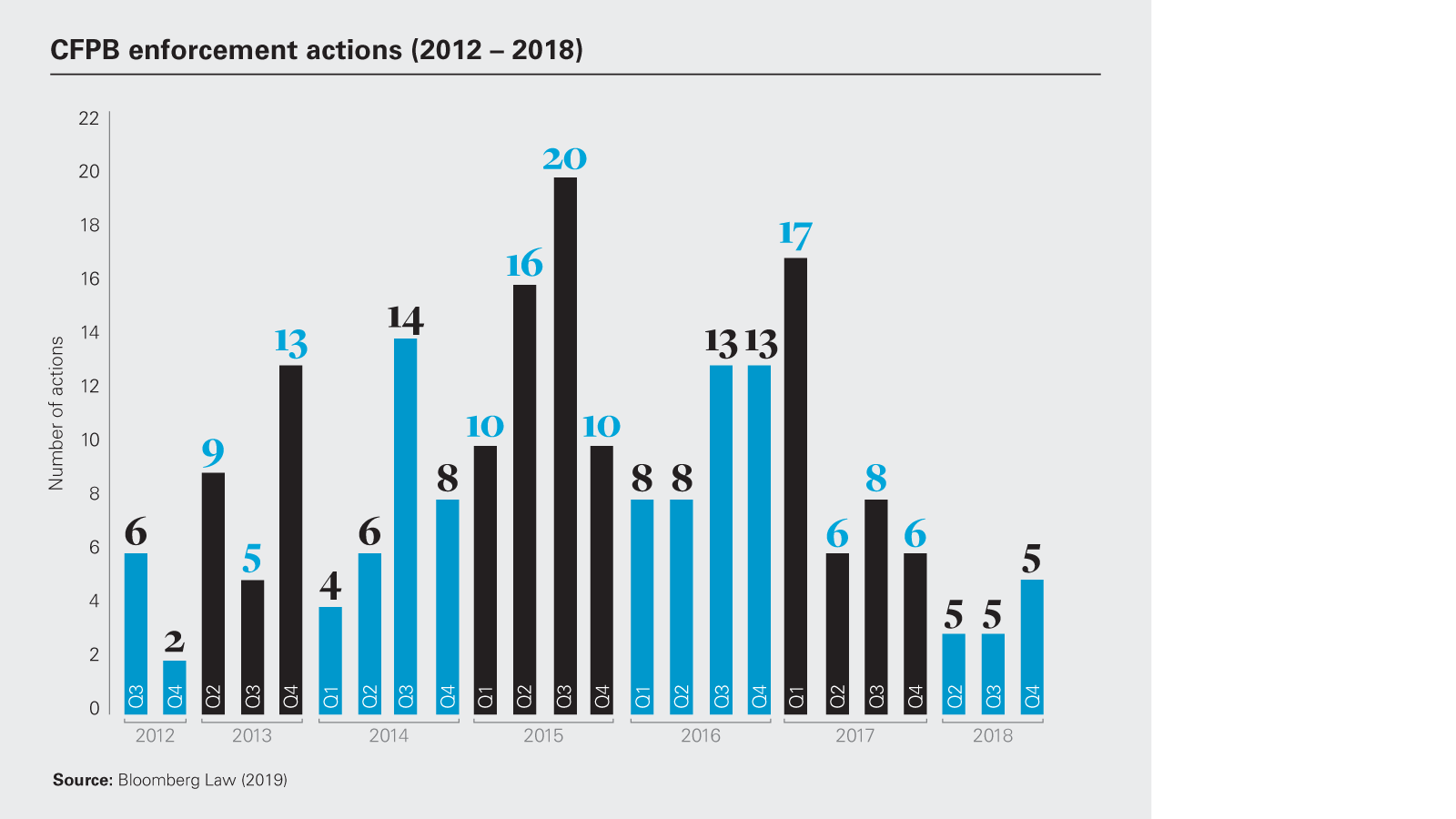I call on Director Kraninger to put consumers first by rolling back the anti-consumer actions taken by [former Acting Director Mulvaney] and allowing the [CFPB] to resume its work of protecting hardworking Americans from unfair, deceptive or abusive practices.”
Rep. Maxine Waters (D-CA), Chairwoman of the House Financial Services Committee1
I am here to be the director of this bureau and I will be fully accountable for the decisions that I make going forward and they will be mine.”
CFPB Director Kathy Kraninger2
2018 in review
In just over a year at the helm of the CFPB, former Acting Director Mulvaney left his mark on the consumer financial watchdog. Chosen by President Trump in late November 2017, his temporary appointment was immediately the subject of litigation lodged by former Deputy Director Leandra English.3 After his appointment was upheld,4 former Acting Director Mulvaney made quick work in reshaping the approach and structure of the Bureau.5 In a series of swift moves, he initiated a sweeping review of the CFPB’s core processes and procedures, placed a moratorium on its enforcement activities (since resumed), and realigned its enforcement, supervisory and rulemaking priorities. Mulvaney also temporarily rebranded the CFPB as the “BCFP,” adopted a Bureau seal, and brought in a dozen political appointees to run daily operations and reorganized the Bureau, limiting the Fair Lending and Student Loan Ombudsman’s Offices to outreach and educational responsibilities. Consumer advocacy groups and Congressional Democrats generally opposed Mulvaney’s efforts to reform the Bureau, as did certain high-profile staffers.6
Enforcement
2018 started with former Acting Director Mulvaney announcing that the Bureau had pushed its “last envelope” and signaling the end to “regulation by enforcement.”7 A look-back at his tenure, however, suggests otherwise. Although the CFPB adopted a less aggressive enforcement approach overall and largely trimmed penalties, the Bureau continued to employ similar legal theories and leveraged its UDAAP authority. Notably, the Bureau brought new allegations of “abusive” conduct shortly after announcing that it was considering engaging in rulemaking to clarify the abusiveness standard in the face of unsettled case law.8
The CFPB kicked off 2019 by settling five actions against a bank, a nonbank retailer and several US- and foreign-based lenders, partly or exclusively relying on its UDAAP authority.9 At the same time, the Bureau significantly reduced its fair lending enforcement activity, and continued to deploy its enforcement resources in other areas of focus, such as disclosures and debt collection.10 The arrival of newly confirmed Director Kraninger brings to the Bureau another period of transition as she determines her enforcement, supervisory and rulemaking priorities.
Rulemaking
Determined to ease regulatory burdens on industry and to issue more formal rulemakings, former Acting Director Mulvaney was quick to address industry concerns and left the Bureau with a packed agenda for Director Kraninger. Among the most notable developments, the Bureau intends to engage in rulemaking to modernize communication and disclosure requirements placed on third-party debt collectors subject to the Fair Debt Collection Practices Act (for which no implementing regulation exists), and clarify the meaning of “abusive” in connection with the CFPB’s UDAAP authority under Section 1031 of the Dodd-Frank Act.11 In addition to shelving or delaying certain rulemaking initiatives introduced by former Director Cordray, the Bureau also expressed an interest in revisiting how it treats disparate impact claims under the ECOA.12 In line with former Acting Director Mulvaney’s intent13 to revamp the Bureau’s payday lending rule (Payday Rule),14 Director Kraninger recently proposed to rescind the Payday Rule’s onerous underwriting requirements and push its compliance date to November 2020.15 In other areas, Director Kraninger may, however, forge her own rulemaking priorities going forward, and will likely draw upon her “listening tour” with relevant CFPB staff and stakeholders to do so.16 Director Kraninger also indicated that she will prioritize data privacy and cybersecurity, two areas that are expected to be hot topics in the coming year.17

View full image
Legislation
While several legislative proposals were introduced in 2018 by congressional Republicans to rein in the CFPB’s authority, none gained any significant traction under the Republican-controlled House and Senate in the last Congress. Such proposals are even less likely to gain momentum with Democrats now in control of the House. New pro-industry bills, such as the Home Mortgage Disclosure Adjustment Act,18 and efforts to repeal the Bureau’s Payday Rule under the Congressional Review Act,19 failed to secure sufficient bipartisan support. The now Democratic-run House Financial Services Committee has wasted no time aggressively scrutinizing the CFPB, including former Acting Director Mulvaney’s decisions.20 Rep. Waters (D-CA), the new Chairwoman of the House Financial Services Committee, may also re-introduce legislation seeking to reverse almost all of the recent structural changes made to the Bureau, thus previewing the committee’s upcoming agenda. Opportunities to pass meaningful legislation will, however, likely stall in the Republican-controlled Senate, and we thus expect that the committee will ramp up political pressure on the Bureau through its oversight and investigatory powers.
A note on new technologies
Faced with an ongoing influx of new actors that leverage increasingly more complex technologies in the CFS sector, federal regulators have so far struggled to provide a coordinated response to such innovation. Although regulatory hesitation for a full embrace of innovative solutions remains, the CFPB has taken notable steps to revamp its no-action letter policy and trial disclosure program to encourage consumer-friendly innovation in the marketplace.21 Differing responses by federal regulators, including the federal bank regulators, will continue, however, to pose ongoing compliance challenges to fintech companies and financial institutions seeking to leverage these new technologies while managing their risk exposure to federal and state regulations.
A new CFPB director: The road ahead
As only the second permanent director in the CFPB’s short history, Director Kraninger will likely echo some of her predecessor’s initiatives; she has already signaled her intent to forge her own legacy by scrapping former Acting Director Mulvaney’s plan to rebrand the Bureau. Notably, comments received from the CFPB’s "Call for Evidence" give her the opportunity to leverage industry insights to implement more substantial and organizational changes at the Bureau.22 As she sets the Bureau’s agenda, Director Kraninger will need to navigate increased oversight by the House Financial Services Committee and take positions on constitutional challenges faced by the Bureau until resolution, if any, by the US Supreme Court. While former Acting Director Mulvaney contended that his ratification of pending litigation cured any alleged constitutional defect, given the President’s ability to remove the interim CFPB Director at will, Director Kraninger will need to rely on other grounds, should additional industry participants contest the constitutionality of future CFPB enforcement actions—provided that she chooses to defend the Bureau’s constitutionality going forward.

View full image
FULL MAGAZINE
Consumer financial services: The road ahead
1 Press Release, Waters Statement on the Confirmation of Kathy Kraninger to Head the CFPB (Dec. 6, 2018), https://financialservices.house.gov/news/documentsingle.aspx?DocumentID=401651.
2 Neil Haggerty, 'I Am Very Excited to Be Here': Kraninger Signals New Tone Atop CFPB, (Dec. 11, 2018), American Banker, https://www.americanbanker.com/news/i-am-very-excited-to-be-here-kraninger-signals-new-tone-atop-cfpb.
3 English v. Trump, case no. 1:17-cv-02534 (D.D.C. Nov. 11, 2017).
4 Id.
5 CFPB, Written Testimony of Mick Mulvaney, Acting Director, Bureau of Consumer Financial Protection, Before the House Committee on Financial Services (Apr. 10, 2018) ("Shortly after President Trump appointed me as Acting Director of the Bureau, I announced that the Bureau would continue to execute the law but would no longer go beyond its statutory mandate"), https://www.consumerfinance.gov/about-us/newsroom/written-testimony-mick-mulvaney-acting-director-before-house-committee-financial-services/.
6 See, e.g., Kate Berry, CFPB's Student Loan Ombudsman Resigns in Scathing Letter to Mulvaney (Aug. 27, 2018), https://www.americanbanker.com/news/cfpbs-student-loan-ombudsman-resigns-in-scathing-letter-to-mulvaney.
7 Mick Mulvaney, Internal Memorandum to CFPB Staff (Jan. 23, 2018), https://www.consumerfinancemonitor.com/wp-content/uploads/sites/14/2018/01/Mulvaney-memo.pdf.
8 CFPB, Fall 2018 Rulemaking Agenda (Oct. 17, 2018), https://www.consumerfinance.gov/about-us/blog/fall-2018-rulemaking-agenda/. See also, e.g., CFPB v. Cash Express, LLC, 2018-BCFP-0007 (Oct. 24, 2018) (the Bureau found that Cash Express violated the Consumer Financial Protection Act by "abusively withholding funds during check-cashing transactions to satisfy outstanding amounts on prior loans, without disclosing this practice to the consumer during the initiation of the transaction").
9 See CFPB v. USAA Federal Savings Bank, 2019-BCFP-0001 (Jan. 3, 2019); Consumer Fin. Prot. Bureau v. Sterling Jewelers Inc., case no. 1:19-cv-00448 (S.D.N.Y. Jan. 16, 2019); CFPB v. Enova Int'l, Inc., 2019-BCFP-0003 (Jan. 25, 2019); Consumer Fin. Prot. Bureau v. NDG Fin., Corp., et al., case no. 1:15-cv-05211-CM (S.D.N.Y. Feb. 2, 2019), https://s3.amazonaws.com/files.consumerfinance.gov/f/documents/cfpb_ndg-financial-corp_consent-order_2019-02.pdf; CFPB v. CMM, LLC, et al., 2019-BCFP-0004 (Feb. 5, 2019), https://s3.amazonaws.com/files.consumerfinance.gov/f/documents/cfpb_cash-tyme-consent-order_2019-02.pdf.
10 See, e.g., CFPB v. National Credit Adjusters, et al., LLC, 2018-BCFP-0004 (Jul. 13, 2018); CFPB v. Triton Mgmt. Group, Inc., et al., 2018-BCFP-0005 (Jul. 19, 2018); Consumer Fin. Prot. Bureau v. Future Income Payment, LLC, case no. 8:18-cv-01654 (C.D. Cal. Sept. 13, 2018); CFPB v. Bluestem Brands, Inc., et al., 2018-BCFP-0006 (Oct. 4, 2018); Consumer Fin. Prot. Bureau v. Village Capital and Investment, LLC, case no. 2:18-cv-02304 (D. Nev. Dec. 4, 2018).
11 12 U.S.C. § 5531.
12 CFPB, Statement of the Bureau of Consumer Financial Protection on Enactment of S.J. Res. 57 (May 21, 2018), https://www.consumerfinance.gov/about-us/newsroom/statement-bureau-consumer-financial-protection-enactment-sj-res-57/.
13 CFPB, CFPB Statement on Payday Rule (Jan. 16, 2018), https://www.consumerfinance.gov/about-us/newsroom/cfpb-statement-payday-rule/.
14 CFPB, Payday, Vehicle Title, and Certain High-Cost Installment Loans (Oct. 5, 2017), https://s3.amazonaws.com/files.consumerfinance.gov/f/documents/201710_cfpb_final-rule_payday-loans-rule.pdf.
15 CFPB, Consumer Financial Protection Bureau Releases Notices of Proposed Rulemaking on Payday Lending (Feb. 6, 2019), https://www.consumerfinance.gov/about-us/newsroom/consumer-financial-protection-bureau-releases-notices-proposed-rulemaking-payday-lending/.
16 Neil Haggerty, "I Am Very Excited to Be Here": Kraninger Signals New Tone Atop CFPB, American Banker (Dec. 11, 2018), https://www.americanbanker.com/news/i-am-very-excited-to-be-here-kraninger-signals-new-tone-atop-cfpb.
17 ABA Banking Journal, Data Security, Privacy to Be Early Focus of CFPB's Kraninger (Dec. 11, 2018), https://bankingjournal.aba.com/2018/12/data-security-privacy-to-be-early-focus-of-cfpbs-kraninger/.
18 H.R. 2954, 115th Congress (2017-2018).
19 H.J. Res. 122 (Dec. 1, 2017); S.J. Res. 56 (Mar. 22, 2018).
20 Press Release, Waters and Green Request Documents from Consumer Bureau on Recent Settlements (Feb. 7, 2019), https://financialservices.house.gov/news/documentsingle.aspx?DocumentID=402128.
21 See, e.g., CFPB, Bureau of Consumer Financial Protection Announces Director for the Office of Innovation (Jul. 18, 2018) (the newly created Office of Innovation will "focus on creating policies to facilitate innovation, engaging with entrepreneurs and regulators, and reviewing outdated or unnecessary regulations" and identifies the encouragement of "consumer-friendly innovation" as "a key priority for the Bureau"), https://www.consumerfinance.gov/about-us/newsroom/bureau-consumer-financial-protection-announces-director-office-innovation/.
22 CFPB, Call for Evidence (Apr. 17, 2018), https://www.consumerfinance.gov/policy-compliance/notice-opportunities-comment/archive-closed/call-for-evidence/.
This publication is provided for your convenience and does not constitute legal advice. This publication is protected by copyright.
© 2019 White & Case LLP










